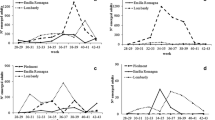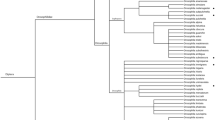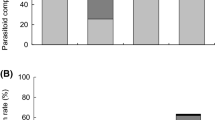Abstract
The invasive spotted wing drosophila, Drosophila suzukii Matsumura (Dipt.: Drosophilidae), a native of East Asia, has widely established in North America and Europe, where it is a serious pest of small and stone fruit crops. The lack of effective indigenous parasitoids of D. suzukii in the recently colonized regions prompted the first foreign exploration for co-evolved parasitoids in South Korea during 2013 and 2014. We collected the larval parasitoids Asobara japonica Belokobylskij, A. leveri (Nixon) and A. brevicauda Guerrieri & van Achterberg (Hym.: Braconidae), Ganaspis brasiliensis (Ihering), Leptopilina japonica japonica Novković & Kimura and L. j. formosana Novković & Kimura (Hym.: Figitidae); and the pupal parasitoids Pachycrepoideus vindemiae (Rondani) (Hym.: Pteromalidae) and Trichopria drosophilae Perkins (Hym.: Diapriidae). From UC Berkeley quarantine records, percentage parasitism ranged from 0 to 17.1 % and varied by geography, season, and collection methods. Asobara japonica was the most common parasitoid species. Higher numbers of parasitoids were reared from field-picked fruit as opposed to traps baited with uninfested fruit. Quarantine bioassays confirmed that A. japonica, G. brasiliensis, L. j. japonica, P. vindemiae, and T. drosophilae developed from D. suzukii. Female individuals of the endoparasitoid, A. japonica, were larger when reared on the larger D. suzukii larvae compared with those reared on the smaller larvae of D. melanogaster Meigen. Larger parasitoid size was associated with longer developmental time. Several of the South Korean parasitoid species have the potential for use in classical biological control and may contribute to the suppression of D. suzukii in the newly invaded regions.




Similar content being viewed by others
References
Adrion JR, Kousathanas A, Pascual M, Burrack HJ, Haddad NM, Bergland AO et al (2014) Drosophila suzukii: the genetic footprint of a recent, worldwide invasion. Mol Biol Evol 31:3148–3163
Asplen M, Anfora G, Biondi A, Choi D-S, Chu D, Daane KM et al (2015) Invasion biology of spotted wing drosophila (Drosophila suzukii): a global perspective and future priorities. J Pest Sci 88:469–494
Atallah J, Teixeira L, Salazar R, Zaragoza G, Kopp A (2014) The making of a pest: the evolution of a fruit-penetrating ovipositor in Drosophila suzukii and related species. Proc R Soc Biol Sci Ser B 281:2013–2840
Beers EH, Van Steenwyk RA, Shearer PW, Coates WW, Grant JA (2011) Developing Drosophila suzukii management programs for sweet cherry in the western United States. Pest Manag Sci 67:1386–1395
Bolda MP, Goodhue RE, Zalom FG (2010) Spotted wing drosophila: potential economic impact of a newly established pest. Giannini Foundation of Agricultural Economics, University of California
Bruck DJ, Bolda M, Tanigoshi L, Klick J, Kleiber J, DeFrancesco J et al (2011) Laboratory and field comparisons of insecticides to reduce infestation of Drosophila suzukii in berry crops. Pest Manag Sci 67:1375–1385
Buffington ML, Forshage M (2016) Redescription of Ganaspis brasiliensis (Ihering, 1905), new combination (Hymenoptera: Figitidae), a natural enemy of the invasive Drosophila suzukii (Matsumura, 1931) (Diptera: Drosophilidae). Proc Entomol Soc Wash 118(1):1–13
Burrack HJ, Fernandez GE, Spivey T, Kraus DA (2013) Variation in selection and utilization of host crops in the field and laboratory by Drosophila suzukii Matsumara (Diptera: Drosophilidae), an invasive frugivore. Pest Manag Sci 69:1173–1180
Calabria G, Máca J, Bachli G, Serra L, Pascual M (2012) First records of the potential pest species Drosophila suzukii (Diptera: Drosophilidae) in Europe. J Appl Entomol 136:139–147
Carton Y, Boulétreau B, van Alphen JJM, van Lenteren JC (1986) The Drosophila parasitic wasps. In: Ashburner M, Carson HL, Thompson JN (eds) The genetics and biology of Drosophila. Academic Press, London, pp 347–394
Chabert S, Allemand R, Poyet M, Eslin P, Gibert P (2012) Ability of European parasitoids (Hymenoptera) to control a new invasive Asiatic pest, Drosophila suzukii. Biol Control 63:40–47
Chiu JC, Jiang X, Zhao L, Hamm CA, Cridland JM, Saelao P et al (2013) Genome of Drosophila suzukii, the spotted wing drosophila. G3 3:2257–2271
Cini A, Anfora G, Escudero-Colomar LA, Grassi A, Santosuosso U, Seljak G et al (2014) Tracking the invasion of the alien fruit pest Drosophila suzukii in Europe. J Pest Sci 87:559–566
Dalton DT, Walton VM, Shearer PW, Walsh DB, Caprile J, Isaacs R (2011) Laboratory survival of Drosophila suzukii under simulated winter conditions of the Pacific Northwest and seasonal field trapping in five primary regions of small and stone fruit production in the United States. Pest Manag Sci 67:1368–1374
Deprá M, Poppe JL, Schmitz HJ, De Toni DC, Valente VLS (2014) The first records of the invasive pest Drosophila suzukii in the South American continent. J Pest Sci 87:379–383
Desneux N, Blahnik R, Delebecque CJ, Heimpel GE (2012) Host phylogeny and specialisation in parasitoids. Ecol Lett 15:453–460
Emiljanowicz LM, Ryan GD, Langille A, Newman J (2014) Development, reproductive output and population growth of the fruit fly pest Drosophila suzukii (Diptera: Drosophilidae) on artificial diet. J Econ Entomol 107:1392–1398
Gabarra R, Riudavets J, Rodríguez GA, Pujade-Villar J, Arnó J (2015) Prospects for the biological control of Drosophila suzukii. Biocontrol 60:331–339
Goodhue RE, Bolda M, Farnsworth D, Williams JC, Zalom FG (2011) Spotted wing drosophila infestation of California strawberries and raspberries: economic analysis of potential revenue losses and control costs. Pest Manag Sci 67:1396–1402
Guerrieri E, Giorgini M, Cascone P, Carpenito S, van Achterberg C (2016) Species diversity in the parasitoid genus Asobara (Hymenoptera: Braconidae) from the native area of the fruit fly pest Drosophila suzukii (Diptera: Drosophilidae). PLoS One 11:e0147382
Hauser M (2011) A historic account of the invasion of Drosophila suzukii (Matsumura) (Diptera: Drosophilidae) in the continental United States, with remarks on their identification. Pest Manag Sci 67:1352–1357
Ideo S, Watada M, Mitsui H, Kimura MT (2008) Host range of Asobara japonica (Hym.: Braconidae), a larval parasitoid of drosophilid flies. Entomol Sci 11:1–6
Ioriatti C, Walton V, Dalton D, Anfora G, Grassi A, Maistri S, Mazzoni V (2015) Drosophila suzukii (Diptera: Drosophilidae) and its potential impact to wine grapes during harvest in two cool climate wine grape production regions. J Econ Entomol 108:1148–1155
Kacsoh BZ, Schlenke TA (2012) High hemocyte load is associated with increased resistance against parasitoids in Drosophila suzukii, a relative of D. melanogaster. PLoS One 7:e34721
Kanzawa T (1939) Studies on Drosophila suzukii Mats (in Japanese): Yamanashi Agricultural Experimental Station. Kofu, Japan
Kasuya N, Mitsui H, Ideo S, Watada M, Kimura MT (2013) Ecological, morphological and molecular studies on Ganaspis individuals (Hymenoptera: Figitidae) attacking Drosophila suzukii (Diptera: Drosophilidae). Appl Entomol Zool 48:87–92
Kinjo H, Kunimi Y, Ban T, Nakai M (2013) Oviposition efficacy of Drosophila suzukii (Diptera: Drosophilidae) on different cultivars of blueberry. J Econ Entomol 106:1767–1771
Klick J, Lee JC, Hagler JR, Bruck DJ, Yang WQ (2014) Evaluating Drosophila suzukii immunomarking for mark-capture research. Entomol Exp Appl 152:31–41
Klick J, Yang W, Walton V, Dalton D, Hagler J, Dreves A, Lee JC, Bruck D (2015) Distribution and activity of Drosophila suzukii in cultivated raspberry and surrounding vegetation. J Appl Entomol. doi:10.1111/jen.12234
Kraaijeveld AR (1999) Kleptoparasitism as an explanation for paradoxical oviposition decisions of the parasitoid Asobara tabida. J Evol Biol 12:129–133
Lee JC, Bruck DJ, Curry H, Edwards D, Haviland DR, Van Steenwyk RA et al (2011) The susceptibility of small fruits and cherries to the spotted-wing drosophila, Drosophila suzukii. Pest Manag Sci 67:1358–1367
Lee JC, Dreves AJ, Cave AM, Kawai S, Isaacs R, Miller JC et al (2015) Infestation of wild and ornamental noncrop fruits by Drosophila suzukii (Diptera: Drosophilidae). Ann Entomol Soc Am 108:117–129
Miller B, Anfora G, Buffington M, Daane KM, Dalton DT et al (2015) Seasonal occurrence of resident parasitoids associated with Drosophila suzukii in two small fruit production regions of Italy and the USA. Bull Insectol 68:255–263
Mitsui H, Kimura MT (2010) Distribution, abundance and host association of two parasitoid species attacking frugivorous drosophilid larvae in central Japan. Eur J Entomol 107:535–540
Mitsui H, Takahashi KH, Kimura MT (2006) Spatial distributions and clutch sizes of Drosophila species ovipositing on cherry fruits of different stages. Popul Ecol 48:233–237
Mitsui H, Van Achterberg K, Nordlander G, Kimura MT (2007) Geographical distributions and host associations of larval parasitoids of frugivorous Drosophilidae in Japan. J Nat Hist 41:1731–1738
Murata Y, Ideo S, Watada M, Mitsui H, Kimura MT (2009) Genetic and physiological variation among sexual and parthenogenetic populations of Asobara japonica (Hymenoptera: Braconidae), a larval parasitoid of drosophilid flies. Eur J Entomol 106:171–178
Nomano FY, Mitsui H, Kimura MT (2015) Capacity of Japanese Asobara species (Hymenoptera; Braconidae) to parasitize a fruit pest Drosophila suzukii (Diptera; Drosophilidae). J Appl Entomol 139:105–113
Ometto L, Cestaro A, Ramasamy S, Grassi A, Revadi S, Siozios S et al (2013) Linking genomics and ecology to investigate the complex evolution of an invasive Drosophila pest. Genome Biol Evol 5:745–757
Poyet M, Havard S, Prévost G, Chabrerie O, Doury G, Gibert P et al (2013) Resistance of Drosophila suzukii to the larval parasitoids Leptopilina heterotoma and Asobara japonica is related to haemocyte load. Physiol Entomol 38:45–53
Poyet M, Eslin P, Heraude M, Le Roux V, Prévost G, Gibert P et al (2014) Invasive host for invasive pest: when the Asiatic cherry fly (Drosophila suzukii) meets the American black cherry (Prunus serotina) in Europe. Agri For Entomol 16:251–259
Rossi Stacconi MV, Grassi A, Dalton DT, Miller B, Ouantar M, Loni A et al (2013) First field records of Pachycrepoideus vindemiae as a parasitoid of Drosophila suzukii in European and Oregon small fruit production areas. Entomologia 1:1–15
Rossi Stacconi MV, Buffington M, Daane KM, Dalton DT, Grassi A, Kaçar G et al (2015) Host stage preference, efficacy and fecundity of parasitoids attacking Drosophila suzukii in newly invaded areas. Biol Control 84:28–35
Steffan SA, Lee JC, Singleton ME, Vilaire A, Walsh DB, Lavine LS et al (2013) Susceptibility of cranberries to Drosophila suzukii (Diptera: Drosophilidae). J Econ Entomol 106:2424–2427
Stewart TJ, Wang X-G, Molinar A, Daane KM (2014) Factors limiting peach as a potential host for Drosophila suzukii (Diptera: Drosophilidae). J Econ Entomol 107:1771–1779
Tochen S, Dalton DT, Wiman N, Hamm C, Shearer PW, Walton VM (2014) Temperature-related development and population parameters for Drosophila suzukii (Diptera: Drosophilidae) on cherry and blueberry. Environ Entomol 43:501–510
Van Alphen JJM, Janssen ARM (1982) Host selection by Asobara tabida (Braconidae: Alysinae) a larval parasitoids of fruit inhabiting Drosophila species 2: host species selection. Neth J Zool 32:194–214
Walsh DB, Bolda MP, Goodhue RE, Dreves AJ, Lee J, Bruck DJ, Walton VM, O’Neal SD, Zalom FG (2011) Drosophila suzukii (Diptera: Drosophilidae): invasive pest of ripening soft fruit expanding its geographic range and damage potential. J Integr Pest Manag 2:G1–G7
Wang XG, Kaçar G, Biondi A, Daane KM (2016) Life-history and host preference of Trichopria drosophilae, a pupal parasitoid of spotted wing drosophila. BioControl. doi:10.1007/s10526-016-9720-9
Wiman NG, Walton VM, Dalton DT, Anfora G, Burrack HJ, Chiu JC et al (2014) Integrating temperature-dependent life table data into a matrix projection model for Drosophila suzukii population estimation. PLoS One 9:e106909
Yu D, Zalom FG, Hamby KA (2013) Host status and fruit odor response of Drosophila suzukii (Diptera: Drosophilidae) to figs and mulberries. J Econ Entomol 106:1932–1937
Acknowledgments
We thank Riki York and Kyoo Park (Oregon State University), Hyun Jung Kim and Jongwoo Nam (Seoul Women’s University), Uk-Jin Park and Rameswor Maharjan (Andong National University), Oh-Gyeong Kwon (Kyungpook National University), Deuk So Choi (Department of Plant Quarantine, Anyang-si), and Iksoo Kim (Chonnam National University, Gwangju) for assistance with collections in South Korea and Hongyin Chen and Chenxi Liu (Chinese Academy of Agricultural Science), Zon Qi Chen and Yang Wang (Yunnan Academy of Agricultural Science) for collections in China; John Hutchins and Brandy Chavez (University of California, Berkeley) for assistance with insect rearing in the quarantine; and Ken Bloem (Biological Control Coordinator, USDA, APHIS, PPQ) for program design. Antonio Biondi was supported through the People Programme of the European Union’s Seventh Framework Programme FP7/2007–2013 Project ASCII-PIRSES 318246 and from the Italian Ministry of Education, University and Research (PRIN project GEISCA, 2010CXXHJE_004). Funding for research was supported in the US by the USDA-NIFA award # 2010-51181-21167, the USDA APHIS (Farm bill, fund 14-8130-0463), and the California Cherry Board, and in Italy by the UE FP7/2007–2013 project ASCII under Grant agreement PIRSES-GA-2012-318246. Mention of trade names or commercial products in this publication is solely for the purpose of providing specific information and does not imply recommendation or endorsement by the USDA. USDA is an equal opportunity provider and employer.
Author information
Authors and Affiliations
Corresponding author
Additional information
Communicated by M. Traugott.
Rights and permissions
About this article
Cite this article
Daane, K.M., Wang, XG., Biondi, A. et al. First exploration of parasitoids of Drosophila suzukii in South Korea as potential classical biological agents. J Pest Sci 89, 823–835 (2016). https://doi.org/10.1007/s10340-016-0740-0
Received:
Revised:
Accepted:
Published:
Issue Date:
DOI: https://doi.org/10.1007/s10340-016-0740-0




